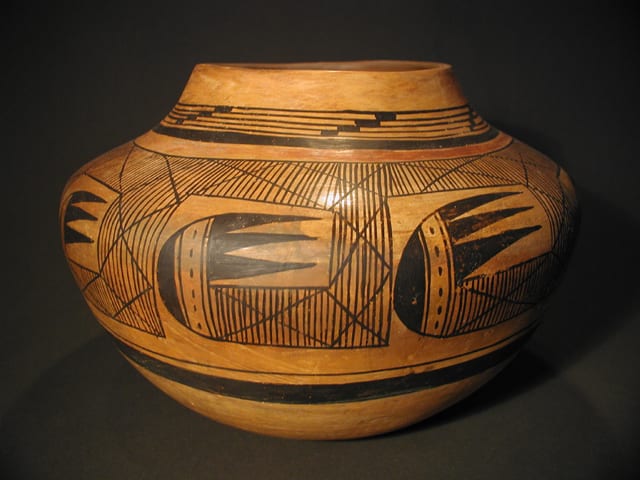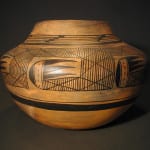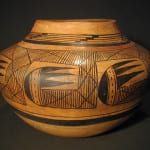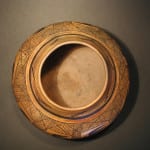A large asymmetric Hopi-Tewa pot with polychromatic design of five thin parallel framing lines around the neck, with intermittent black squares forming “steps,” two thicker framing lines, the bottom one is faded and is the only red on the pot, a wide band formed of half “bat wings” all pointed to the left and, finally, two bottom framing lines, the lower thicker. Unsigned, ca 1905. The pot was made by Nampeyo and probably painted by Annie.
The shape of the pot is asymmetric and the painter seems to have tried to adjust a symmetric design to fit the pot, with mixed results. Moreover, the pot seems to have some overall scorching from outdoor firing. My attribution of this pot to Nampeyo and Annie barely meets Marti Cusick’s (Struever’s) standard for the designation “probably painted by a member of Nampeyo’s family,” which Cusick defines as “where certain patterns appear that have become classic Nampeyo family designs (1984:np).” The shape of 2002-09 and the overall design effect is similar to a much larger pot now in the Denver Art Museum that is attributed to Nampeyo, 1920-1935 but was probably painted by Annie (Struever, 2001:32, #39). During a January 2005 visit to his home in Sedona, Ed Wade showed me a very similar (though symmetrical) pot by Nampeyo. In July 2009 Wade confirmed the Nampeyo/Annie origin of the jar (see below). I am told that a jar with similar painting is in the collection of the Milwaukee Public Museum.
Most convincing is the delicate busy composition of the design and design elements that reflect the style of Annie. The overall composition, from the upper framing lines, black steps, single red stripe, and delicate crosshatching are typical of Annie’s crowded, delicate painting. Note especially that the wingtips are finished with a series of dots—a design element some authorities believe is unique to Annie. As Barbara Kramer wrote (1996:162): “ As (Annie’s) work matured, it had a more delicate, horizontal feeling to it, like slanted penmanship, She was the first to repeatedly paint migration designs, her signature dots identifiable at the end of the ‘wingtips’ (Plate 16).” This distinctive Annie “wingtip” design is evident in Rick Dillingham’s signed Annie pot (Blairs, 1999:XIV, C) and in a signed Annie pot for sale by Tonia Sedlock on eBay 1/16/02 and 2/22/02. [eBay printout and large glossy pictures of the Sedlock pot are in my records.] This same wing-tip design is the basis for Barbara Kramer’s belief that 1996-05 was painted by Annie.
Kramer’s belief that Annie distinctively finished her batwing design with a series of dots is contested by Ed Wade, who (from website photos) evaluated 2002-09 in July 2009 and confirmed the pot as probably a collaborative mother-daughter product:
“Though diminutive, this vessel is made in the shape classic for Nampeyo’s largest storage jars, which she produced most prolifically between 1900 and 1915. The Arizona State Museum has a number of these vessels and they were a favorite of the Fred Harvey Company as parlor pieces and presentation objects.
The composition is a variant of what would later become known as the “Migration Pattern” with its undulating diagonal S-scroll. Writers have attached fanciful names to many such design variants—such as bat-wings, spider, crescent horns, and such; however all their origins extend back into the prehistory of Hopi ceramics as expressed in both Black on white wares and particular Jeddito Black on yellow.
A great deal of misconception surrounds the origin of the migration pattern, with certain authors maintaining it was the creation of Nampeyo’s eldest daughter Annie during the teens or early 1920s, while others argue that one can tell the hand of Annie or Nampeyo owing to the inclusion of stepped diagonal fillers or serially repeated lines within the D-shaped claw-like element, as seen in the vessel above. At best this is loose conjecture.
We do know that by the turn of the 20th century, as with the bowl pictured below, collected in 1904, Nampeyo had perfected the design, and that by 1900 at the latest, shown in the composition of the following exquisite Black on white bowl, that variants of the design had proliferated.
As true of any artist, both Nampeyo and Annie had their on and off days, making it difficult at times for scholars to positively identify who exactly executed a composition. Such is the case with this particular jar. My inclination, however, is to assign the painting to Annie, although there are some compelling Nampeyo traits also evident.
When Annie was painting as herself and not fused with the persona of her mother, her line work tended to be more fluid and uneven. The fastidiousness of Nampeyo is well illustrated in the pearly white bowl above. Annie also favored positive over negative motifs, again a trait seen in the jar within this collection.
The choice of clay also is telling since Annie preferred high hematite content in the production of her Red Wares and rosy flushed coal fired ceramics.
Distinctively Nampeyo, however, is the encircling multiple lined neck banding with diagonal stair-stepped squares. The visual allusion suggests musical notation and a contrapuntal movement of the neck in contrast to the body design. Another rarely seen Nampeyo trait is the highly polished red slipped band separating the neck from body composition.
This is a mother daughter collaborative work, but exactly how much was done by any one party is open for speculation.”
–Edwin L. Wade
Note that Ed’s comment that
“Distinctively Nampeyo, however, is the encircling multiple lined neck banding with diagonal stair-stepped squares.”
In a book published 13 years later, Ed shows a photograph of a jar with a migration design and a neck band like that on jar 2002-09. Of the published jar he writes:
“Most telling is the signature secondary neckband of finely drawn encircling lines internally accented by diagonal rectangular blocks. This aspect of the vessel is Annie, as documented on scores of her painted compositions. (Wade and Cooke, 2020:198)”
It’s a measure of the seriousness of a scholar that she/he can change their opinion over time, as Ed seems to have done here. Nevertheless, for both of these jars with similar neckbands, Ed concludes that they are a joint product of Momma Nampeyo and daughter Annie.
Wade’s belief that the dotted wing-tip design is not indicative of Annie’s work is supported by a jar in the collection of the Museum of Northern Arizona, identified as made by Nampeyo and incorporating a design that was adopted by the museum as its logo and also incorporating the dotted wing-tip design.
Perhaps, in Barbara Kramer’s memorable phrase, jar 2002-09 is the world’s best example of a Nampeyo “PMS jar.” (See Barbara’s 11/22/97 letter to me, p. 2, regarding 1993-04.) Barbara and her husband Jim were showing slides of Nampeyo pots to Priscilla Namingha Sahmie and her daughters Jean and Rachel. “We were discussing a less than perfect design or painting” Kramer writes, “and Rachael commented that maybe Nampeyo was suffering PMS that day, which got us all laughing. We just don’t project human frailties to great people of the past. She (Nampeyo) didn’t destroy every vessel that wasn’t technically perfect; she didn’t think in terms of museum quality. If it wasn’t quite right, well it probably was just one of those days. Fortunately or unfortunately, she was technically perfect most of the time so we take that as a standard.”
In short, 2002-09 is a pot made imperfectly with great potential and obvious flaws. It is a poignant reminder of a talented, hard-working family producing pottery to provide income. Four other pots in the collection were probably formed by Nampeyo and painted by Annie: 1996-05, 1997-04, 2000-07 and 2006-01.




